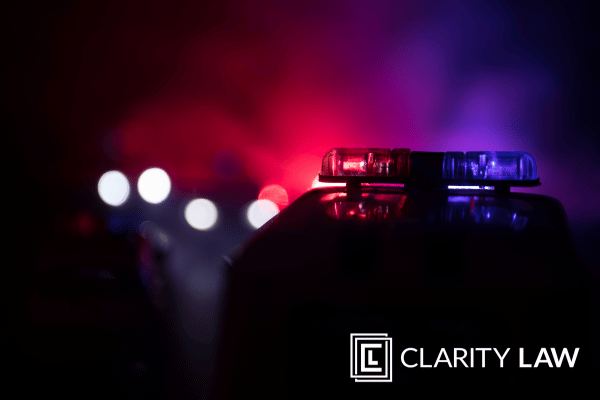Defences to a charge of evading police
The charge of evading police is an extremely serious charge with the Queensland Government enacting some of the toughest legislation in the country. The government have shown a continued desire to see people jailed for evading the police.
The question then becomes are there any defences to the charge of evading police?
First we will look at what evading police is, then the consequences and finally we will look at 5 potential defences.
What is evading police?
Section 754 of the Police Powers and Responsibilities Act 2000 (Qld) provides that to be charged with evading police (also called failure to stop) the driver of a motor vehicle must have failed stop the motor vehicle as soon as reasonably practicable after a police officer has directed them and a reasonable person would have stopped the motor vehicle in the circumstances.
Generally the offence would occur when a police officer in a police vehicle attempts to stop a driver who fails to do so within a reasonable time and thus evades police.
What is the punishment for evading police?
The law provides the penalty as:
Minimum penalty—50 penalty units or 50 days imprisonment
Maximum penalty—200 penalty units or 3 years imprisonment
This meant that the court has to impose either a fine of $7,740 (a penalty unit is currently $154.80) or a term of imprisonment or no less than 50 days.
The law also provides a minimum drivers licence disqualification of 2 years and unfortunately the court cannot grant a work licence or hardship licence.
Evading police is also classed as a type 1 hooning charge which can have quite severe consequences. For the first Type 1 offence, the vehicle can be impounded or immobilised for 90 days. For the second offence the vehicle can be impounded and may be confiscated at the end of any legal proceedings against you,
I’ve received an evasion notice because my car was involved in a police chase
If the police are unable to intercept the vehicle then they may choose to serve an evasion offence notice on the registered owner of the motor vehicle. If that occurs the owner of the motor vehicle has 14 business days to give a declaration to the police otherwise they will be deemed to be the driver of the vehicle involved in the evasion offence.
It is critical to respond to the evasion notice within the time limits and to get legal advice about that declaration.
We have a full article on what to do if you are served an evasion notice.
Are there any defences to the charge of evading police?
Some possible defences to an evasion charge might be that;
- the driver stopped the vehicle as soon as practical
- a reasonable person would not have stopped the vehicle in the circumstances
- the police officer was not in a police vehicle at the time of the direction to stop
- someone else was driving the vehicle
- the direction to stop was not given clearly and the driver did not realise they were directed to stop
Lets look at each of those defences in turn.
Defence 1: the driver stopped the vehicle as soon as practical
Whether the driver stopped the vehicle in time is obviously something that will be unique to each case and depends very much on the circumstances.
The courts have said that in relation to similar laws that;
“the question whether a measure is or is not reasonably practicable is one which requires no more than the making of a value judgment in light of all the facts. Nevertheless, three general propositions are to be discerned from the decided cases:
- The phrase “reasonably practicable” means something narrower than “physically possible”
- What is “reasonably practicable” is to be judged on the basis of what was known at the relevant time; and
- To determine what is “reasonably practicable” it is necessary to balance the likelihood of the risk occurring against the cost, time and trouble necessary to avert that risk”
This defence will really come down to looking at all the facts and deciding at the time of the alleged offence did the driver stop as quickly but safely as possible given the road conditions at the time.
Defence 2: a reasonable person would not have stopped the vehicle in the circumstances
It is sufficient evidence of the commission of the offence if the evidence is that the driver, in failing to stop, took action to avoid being intercepted by a police officer.
Defence 3: the police officer was not in a police vehicle at the time of the direction to stop
This pretty obvious. The police officer must be using a police vehicle at the time they tried to stop the other vehicle. A police vehicle is not defined but would likely mean any vehicle owned by the Queensland police service.
Defence 4: someone else was driving the vehicle
Again this is pretty obvious if someone else was the driver then this would be a defence. It is critical to note that where the police have not been able to identify the driver they will serve an evasion notice on the owner of the vehicle. This requires the owner within 14 days to provide a statutory declaration that names the driver or if they claim not to know who the driver then the declaration must cover all of the following:
- where the owner was when the evasion offence occurred
- the usual location of the vehicle when it is not being used
- the name and address of each person (a potential driver) known by the owner to have access to drive the vehicle when evasion offence occurred
- the way each potential driver has access to drive the vehicle Example—A potential driver possesses a key for the vehicle and has access to where the vehicle is kept
- how frequently each potential driver normally uses the vehicle and for how long each potential driver normally uses the vehicle
- whether each potential driver uses the vehicle in connection with a business or for private use
- whether the vehicle was reported as stolen, or otherwise being used without consent, when the evasion offence happened
- the nature of the inquiries made by the owner to find out who was driving the vehicle when the evasion offence happened
If they don’t provide this information the owner can be declared the driver and subject to prosecution.
We have a full article on what to do if you are served an evasion notice.
Defence 5: the direction to stop was not given clearly and the driver did not realise they were directed to stop
The law sets out how the police must give a direction to stop. The law states that to give a direction the following must occur:
- the police officer is in or on a Queensland police service motor vehicle that is being used to attempt to intercept the motor vehicle the driver is driving; and
- the driver of the police service motor vehicle brings that motor vehicle to a position in relation to the other motor vehicle where the driver or another police officer in or on the police service motor vehicle can give the driver of the other motor vehicle a direction to stop the other motor vehicle; and
- the police officer signals to the driver of the other motor vehicle to stop the motor vehicle—
- by giving a physical or audible signal; or
- by displaying a warning light or warning lights and sounding an alarm.
A warning light is defined as:
- flashing blue and red lights;
- a flashing blue light;
- another flashing light, including alternately flashing headlights and alternately flashing tail-lights.
It is immaterial that the driver had a mistaken belief that the motor vehicle from which the police officer was giving the direction was an emergency vehicle unless the driver proves, on the balance of probabilities, that a reasonable person in the circumstances would have believed the motor vehicle was an emergency vehicle.
An emergency vehicle is listed as any of the following:
- the Queensland Ambulance Service
- an ambulance service of another State
- the Queensland Fire and Emergency Service
- fire brigade or service of another State.
This is very complicated area of law and you will need legal advice to determine if you have any defences to an evasion charge.
Summary of evading police offence and potential defences
-
Definition of Evading Police
-
Failure to stop a motor vehicle promptly after a police officer has directed them.
-
Occurs when a driver fails to stop within a reasonable time, evading police.
-
Penalties for Evading Police
-
Minimum: 50 penalty units or 50 days imprisonment.
-
Minimum 2-year driver's license disqualification; no work or hardship license available.
-
Classified as a Type 1 hooning charge with additional consequences for repeat offenses.
-
Evasion Notice for Vehicle Owners
-
If police can't intercept the vehicle, they may serve an evasion notice on the registered owner.
-
Owner must respond within 14 business days, providing a declaration about the driver's identity.
-
Potential Defences:
-
Defence 1: Driver Stopped Promptly
-
Depends on unique circumstances of each case.
-
Courts consider if the driver stopped as quickly and safely as possible given road conditions at the time.
-
Defence 2: Reasonable Person Wouldn't Have Stopped
-
Sufficient evidence to prove charge if the driver took action to avoid interception by a police officer.
-
Defence 3: Officer Not in Police Vehicle
-
Police officer must be in or near a police vehicle at the time of the direction to stop.
-
Defence 4: Someone Else Was Driving
-
Clear defence if someone else was the driver.
-
If the driver can't be identified, an evasion notice may be served on the owner.
-
Defence 5: Unclear Direction to Stop
-
Specifies how police must give a direction to stop.
-
Driver's belief about the police vehicle being an emergency vehicle is immaterial, unless proven reasonable.
How do I get more information or engage you to act for me?
If you want to engage us or just need further information or advice then you can either;
-
Use our contact form and we will contact you by email or phone at a time that suits you
-
Call us on 1300 952 255 seven days a week, 7am to 7pm
-
Click here to select a time for us to have a free 15 minute telephone conference with you
-
Email This email address is being protected from spambots. You need JavaScript enabled to view it.
-
Send us a message on Facebook Messenger
-
Click the help button at the bottom right and leave us a message
We are a no pressure law firm, we are happy to provide free initial information to assist you with information on failure to stop charges and any defences. If you want to engage us then great, we will give you a fixed price for our services so you will know with certainty what we will cost. All the money goes into a trust account monitored by the Queensland Law Society and cannot be taken out without your permission.
If you don’t engage us that fine too, at least you will have more information on the charge and its consequences.
Need more information?
We have a range of articles on our traffic law blog. Some of the most recent have included:
- Top 5 Drink Driving Myths
- The Essential Guide to Obtaining a Work Licence
- How Drink Driving Matters are Heard in Queensland
- What happens after your drivers licence is disqualified?
- Refusing a Breathalyser Test in Queensland
- Can you commit a drink driving offence in your driveway?
- High Range DUI
- Going through a drink driving charge in Brisbane Magistrate Court
- DUI Charges
- Ultimate Guide to High Range Drink Driving
- Can you beat a DUI?
- Work Licence Affidavits
- Drink Driving Lawyers Brisbane
- Drink Driving Lawyers Gold Coast
- Drink Driving Lawyers Sunshine Coast
- Drink Driving Lawyer Ipswich
- Drink Driving Lawyer Beenleigh
- Drink Driving Lawyer Caboolture
- Drink Driving Lawyer Strathpine
- Criminal Lawyer
- Evading the police
- Can you be charged for watching other people do a burnout?
- Why You Should Never Represent Yourself in Court for a traffic matter
- Traffic Offender Programs
- What is a Traffic Lawyer?
- What Happens After Police Have Charged Me with a Traffic Offence?
- Do you need a Traffic Lawyer?
- Negotiating with a Prosecutor in Queensland
- What is a QP9 and why is it important to your charge?
- Disqualification vs Suspension, what is the difference in Queensland?
- Will I get a criminal conviction for a drink driving charge?
What our clients say about us






